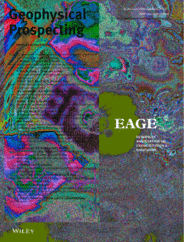
Full text loading...
 , Jianxin Wei1,2, Bangrang Di1,2, Xiang‐Yang Li1,2, Lianbo Zeng1
, Jianxin Wei1,2, Bangrang Di1,2, Xiang‐Yang Li1,2, Lianbo Zeng1
Fractures usually spread over various scales and strongly influence velocity and anisotropy. We investigate elastic velocity and anisotropy in rocks with fractures of different sizes. Based on synthetic rocks with controlled fracture geometries, we create a set of rocks with fracture diameter of 2, 3 and 4 mm and the fracture thickness is 0.06 mm. P‐ and S‐wave velocities are measured at 0.1 MHz, while the rocks are saturated with water and air. For a fixed measurement frequency (0.1 MHz), velocities are higher in rocks with larger fractures, while anisotropy is higher in rocks with smaller fractures, even for the same fracture density. These phenomena are associated with the wave‐induced fluid flow process. Some novel effective medium theories are adopted to calibrate with the laboratory data and analyse the anisotropy affected by the fluid flow mechanism and fracture size. The results of our study demonstrate the significant effects of fracture scale on wave responses by effective medium theories in different ways. We suggest that these scale effects should be of considerable concern in some disciplines (e.g. shear wave splitting in earth's crust and hydraulic fracture monitoring with microseismic data). Considering the scale effects of fractures, the accuracy during these investigations would be improved.

Article metrics loading...

Full text loading...
References


Data & Media loading...

